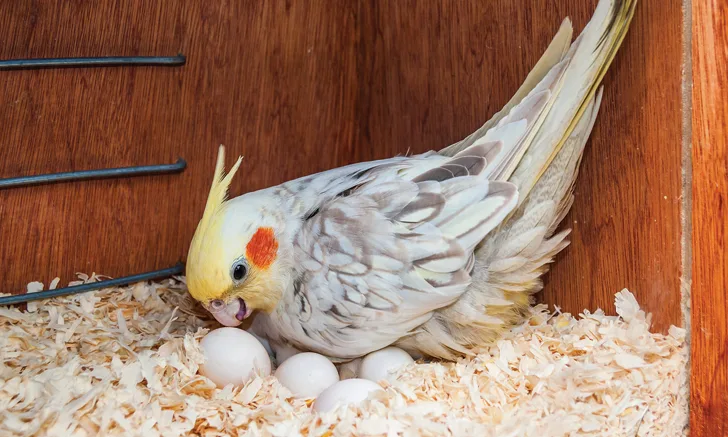Egg Binding in Pet Birds
Anthony Pilny, DVM, DABVP (Avian), The Center for Avian and Exotic Medicine, New York, NY

Egg binding is the failure of an egg to pass within a normal period of time. Although there can be variability and numerous additional factors affecting egg laying, most birds will form and lay an egg 24 to 26 hours following ovulation; eggs are generally laid 48 hours apart.<sup1 sup>
The follicle will travel the length of the reproductive tract while spending variable amounts of time in different anatomic parts; however, the majority of time is spent in the uterus, where the shell is applied before laying.
Causes of egg binding may include chronic egg laying with oviductal muscle dysfunction, vitamin deficiencies, malformed eggs, damage to the oviduct, systemic disease, species predilection, or calcium metabolic syndrome that relates to calcium exhaustion or lack of absorption or availability. First-time egg-laying hens may be predisposed to egg binding or dystocia.2 If left untreated, egg binding can result in long-term egg retention and granuloma formation, uterine impaction, extra-uterine eggs, and death.
Cockatiels, budgerigars (ie, parakeets), and finches are the most popular pet birds worldwide and the species most commonly affected by egg binding.3 These birds tend to present with more severe clinical signs, possibly because of their small size.3
Clinical Signs
Clinical signs vary according to severity and secondary complications. Common signs include depression, abdominal straining and distention, persistent tail wagging, a wide stance, failure to perch, dyspnea, and/or sudden death. An egg lodged in the pelvic canal may compress the pelvic blood vessels, kidneys, pelvic plexus, and other local nerves. This can cause circulatory shock, lameness, and paresis.1
Related Article: The Avian Physical Examination
Figure 1. Standard full-body radiograph of an egg-bound pet bird with a large, retained egg.
Diagnosis
Diagnosis may be made based on history, clinical signs, and palpating an egg in the coelomic cavity. Some of these patients are presented in critical condition, and extreme caution should be taken during handling and treatment; even the mildest diagnostic procedure may result in death in a fractious bird.
A shelled egg may be palpated in the coelomic cavity; radiographs will confirm diagnosis if the egg is shelled (Figure 1). Nonshelled eggs (ova) may be more difficult to diagnose, as palpation and radiography may not readily detect the soft-tissue mass. A CBC and plasma chemistry profile may be beneficial in identifying any predisposing and secondary diseases (eg, hypocalcemia). This may be present if a hen has been consuming a calcium-poor diet or has been laying an excessive number of eggs, which can deplete calcium stores.
Related Article: Avian Venipuncture
Treatment
Therapy varies with history, severity of clinical signs, and diagnostic test results. Supportive care includes elevated environmental temperature, parenteral calcium (50-100 mg/kg IM when necessary4) and vitamin D3 (1000 U vitamin D3/300g body weight IM every 7 days4), fluid therapy, and nutritional support by gavage feeding of a commercial avian nutritional formula or a hand-rearing formula.
Broad-spectrum antibiotics such as enrofloxacin (15 mg/kg PO, SC, IM twice a day3) or amoxicillin-clavulanate (125 mg/kg PO twice a day) are indicated if infection is suspected, and analgesics (eg, butorphanol [1-2 mg/kg IM3], meloxicam [0.5-1 mg/kg PO or IM once a day3]) are indicated for pain that is part of the pathologic state.4 The patient should be switched to oral dosing after 1 or 2 injections to reduce the risk for muscle necrosis. Supportive care alone is often enough to allow oviposition in stable birds, although the hen should be monitored closely for deterioration.
If supportive care and medical therapy fail, ovocentesis may be performed to facilitate passage of the egg. After the patient is stabilized for sedation, aspiration may be performed through the cloacal opening if the egg is visible or transabdominally if the egg is more cranial. Aspirating the contents of the egg while the shell is manually collapsed can allow for manual removal, or the egg pieces may be left to pass during the following week.
Medical therapy with leuprolide acetate (200-800 µg/kg IM every 3-6 weeks3) to reduce reproductive hormone levels and suppress reproductive activity can be administered to temporarily prevent further egg production.
Figure 2. Postoperative salpingohysterectomy image of a severely impacted reproductive tract caused by chronic egg binding. Numerous yolk granulomas can be seen filling the reproductive tract. An extra-uterine egg and granuloma were noted in the coelomic cavity.
Salpingohysterectomy, or surgical removal of the oviduct and uterus, may be needed to resolve chronic egg binding or retained eggshells and to prevent further reproductive complications (Figure 2).
Related Article: Backyard Chickens
Prognosis
Prognosis is usually good depending on patient stability at presentation, length of time clinical signs have been present, and successful egg removal. Prognosis for surgery is good with a skilled avian surgeon and if the egg and oviduct are removed to prevent any future egg laying.